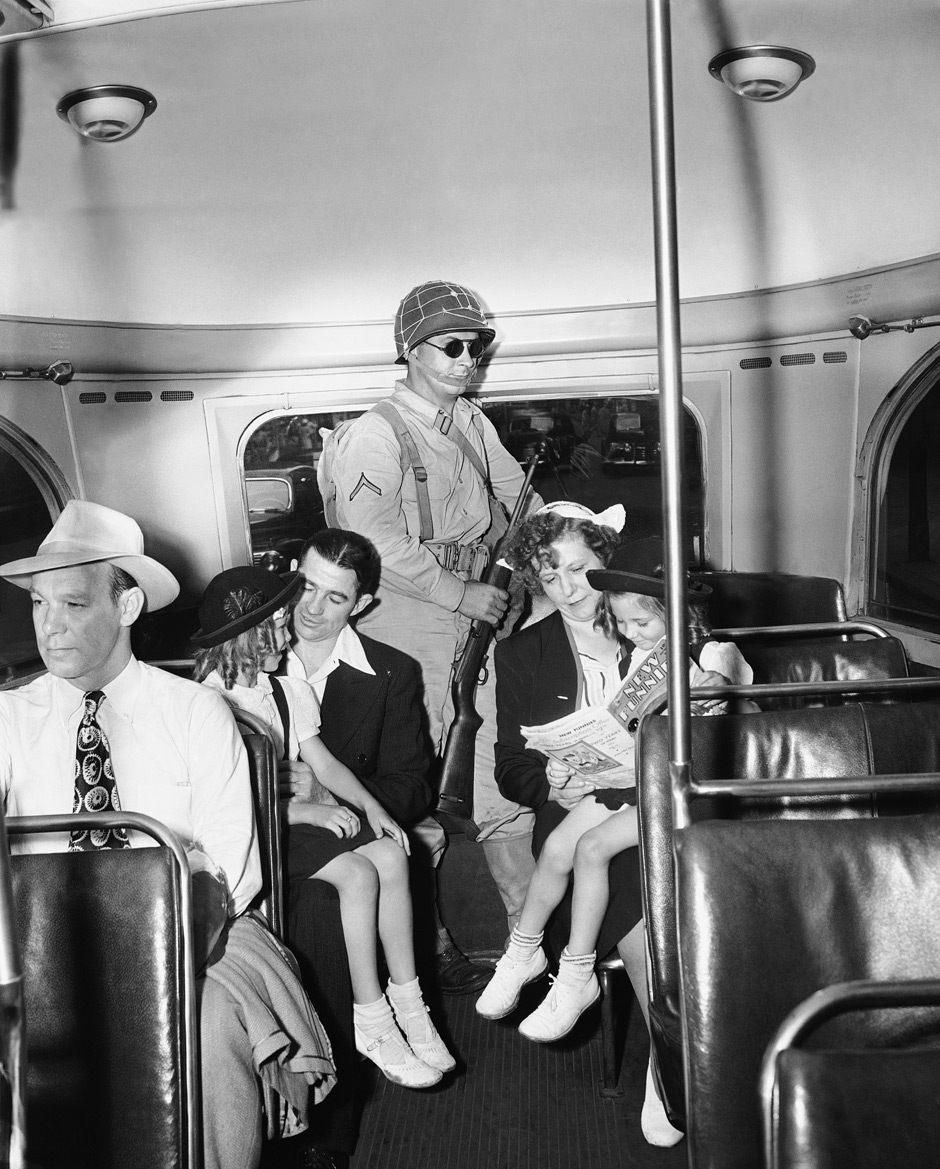Race and the Roots
of Philly Transit Strikes

In this Aug. 6, 1944 file photo an armed soldier stands guard in the back of a trolley in Philadelphia. President Franklin D. Roosevelt sent troops to break up a strike by transit workers who were protesting the hiring and promotion of African-Americans. (AP Photo/John Lindsay, File)
As this is being typed, the news reports about contract negotiations between SEPTA and Transport Workers Union Local 234 sound increasingly optimistic. One of the main sticking points, pensions, has been resolved, and both the transit agency and TWU Local 234 head Willie Brown have issued statements saying that they hope a strike can be averted.
Yet some issues, including health care and worker surveillance, remain unresolved, and the union still stands ready to take a vote to strike when contracts for two TWU 234 suburban bargaining units expire on April 7th.
You may recall that initial strike threat was announced with incendiary language from Brown. Many, including this writer, found that rhetoric off-putting, or worse. But, as with so much else in this city, if you dig down far enough, you might just hear the ghosts of the past raising their voices through the mouth of Brown.
In this case, the ghosts are those of a racially motivated walkout that brought the TWU onto the local labor scene — and Federal troops onto the city’s streetcars.
The two events are connected: The TWU had just won the right to represent Philadelphia’s transit workers in 1944 — right in the middle of a three-year fight to get the Philadelphia Transportation Company (which ran buses and trolleys in the city) to end discrimination against black workers.
For years, an unwritten policy backed by white employees and enforced by the PTC restricted black employees to the most menial positions in the company. The most prized jobs — including that of motorman, or trolley operator — were reserved for white employees only.
But in 1941, President Franklin Delano Roosevelt signed two executive orders outlawing discrimination in war production industries — and transporting workers to the plants was one of those industries.
For the next three years, the Federal government tried to persuade the PTC to implement fair employment practices. Company management pointed to a “customs clause” in its contract with its in-house union to resist the Feds’ entreaties. The local NAACP also protested the policy with a campaign that asked “We drive tanks, why not trolleys?”
Things finally came to a head in 1944. The previous year, the PTC had asked the United States Employment Service (USES), which supplied workers for war production industries, to furnish 100 white motormen for vacant openings. The USES refused to do so, citing the fair employment policy. PTC management relented a bit, saying it would open the positions to anyone if the motormen were willing to go along, but their representatives continued to insist on observing that “custom.”
As 1943 stretched into 1944, the dispute wound its way through the courts, which sided with the government. In the meantime, workers were choosing who would represent them in upcoming negotiations for a new contract to take effect in February 1944. Enter the TWU, which, as an affiliate of the left-leaning Congress of Industrial Organizations, had publicly supported the government’s position. Its promise of a better contract trumped the racial fears of the workers, who voted it in as their representative over both the in-house union and a larger American Federation of Labor affiliate.
In July, the War Manpower Commission ruled that all hiring of men for war production had to take place through the USES. PTC management, seeing the handwriting on the wall, finally announced that it would accept blacks for motorman openings. The first black operators were to take cars out for training runs on August 1st.
On that day, the white operators staged a sickout. They quickly blocked access to PTC depots, shutting down the city’s transit system. The effect on war production was immediate and severe as workers could not reach their jobs. The TWU urged the wildcat strikers to return to work, but to no avail. For its part, PTC management only tepidly asked the strikers to return and actually petitioned the government to suspend the nondiscrimination order.
On the third day of the strike, things came to a head. Roosevelt used a law passed over his veto to authorize a Federal takeover of the PTC. Two days later, with white resistance unabated, the government sent the military in to operate the streetcars. Army Major General William Hayes, the man in charge of the troops, then issued an ultimatum to the strikers: Return to work by 12:01 a.m. on August 7th or lose your draft deferments, your ability to find other war work, and your eligibility for unemployment compensation.
The white strikers gave in.
The NAACP accused PTC management afterwards of secretly using the racial standoff as a means to oust the newly certified TWU as the workers’ representative. And while the whole dispute passed without widespread violence, thanks in part to actions taken by state and local government officials to close liquor stores and bars, it no doubt poisoned relations between TWU leaders and PTC management.
Neither the workforce nor the management are the same today. According to SEPTA, 35 percent of all agency managers are African-American, compared with none in 1944. In addition, 61 percent of the agency’s overall workforce, and a whopping 81 percent of the vehicle operators, are African-American as well. In a very real sense, labor negotiations at SEPTA now are a black thing, but one we call can understand.
But as we all know, this is a city where the past is ever present. And I for one just can’t help but think that this past continues to inform attitudes in the present. Perhaps today’s news is a sign that we may finally have overcome that past. But the story isn’t over yet.
Follow @MarketStEl on Twitter.


